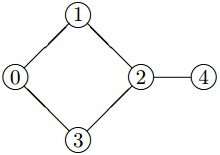Programming contestsACM ICPC programozó csapatverseny, házi forduló, 2016. október 15.
October 15, 2016, 10:00 AM –
October 15, 2016, 3:00 PM
|
Squawk Virus
Oh no! Hackers are threatening to shut down Twitface, the premier social networking site. By taking advantage of lax security protocols, nefarious cyber-bandits have developed a virus that spreads from user to user, amplifying over time and eventually bringing the network to its knees from massive congestion. Normally, users have to manually send messages to one another (squawking), but these ne'er-do-wells have figured out how to circumvent that rule, and have created squawks that spawn more squawks without user intervention. In particular, any time a user gets an infected squawk, one minute later it broadcasts an infected squawk to all its neighbors in the network (for purposes of this problem, we assume that each neighbor gets the squawk exactly 1 minute after the initial user is infected). If a user receives multiple squawks at any point, the next minute it broadcasts that many squawks to all of its neighbors.
For example, consider the following network:

If user 0 is infected at time t = 0, then at time t = 1, users 1 and 3 get 1 squawk each, at time t = 2, users 0 and 2 get 2 squawks each, and at time t = 3, users 1 and 3 get 4 squawks each, and user 4 gets 2 squawks.
Given the layout of a social network and an initial infection site, you need to determine how many squawks are made at some given time t. In the above example, the number of squawks would be 2, 4, and 10 at times 1, 2, and 3, respectively.
Input Specification
The input contains several test cases. Each test case will start with a line containing 4 integers n, m, s, and t, indicating the number of users (1 ≤ n ≤ 100), the number of links between users (0 ≤ m ≤ n(n – 1)/2), the index of the initially infected user (s < n), and the number of minutes (t < 10). Next will follow m lines, each consisting of two integers x and y (0 ≤ x, y < n), indicating that users x and y are connected. Connections are symmetric, and no two connections will be the same.
Output Specification
For each test case, output the number of squawks sent at the specified time t, on a line by itself.
Sample Input
4 3 1 40 11 22 35 5 0 30 10 31 22 32 4
Output for Sample Input
810